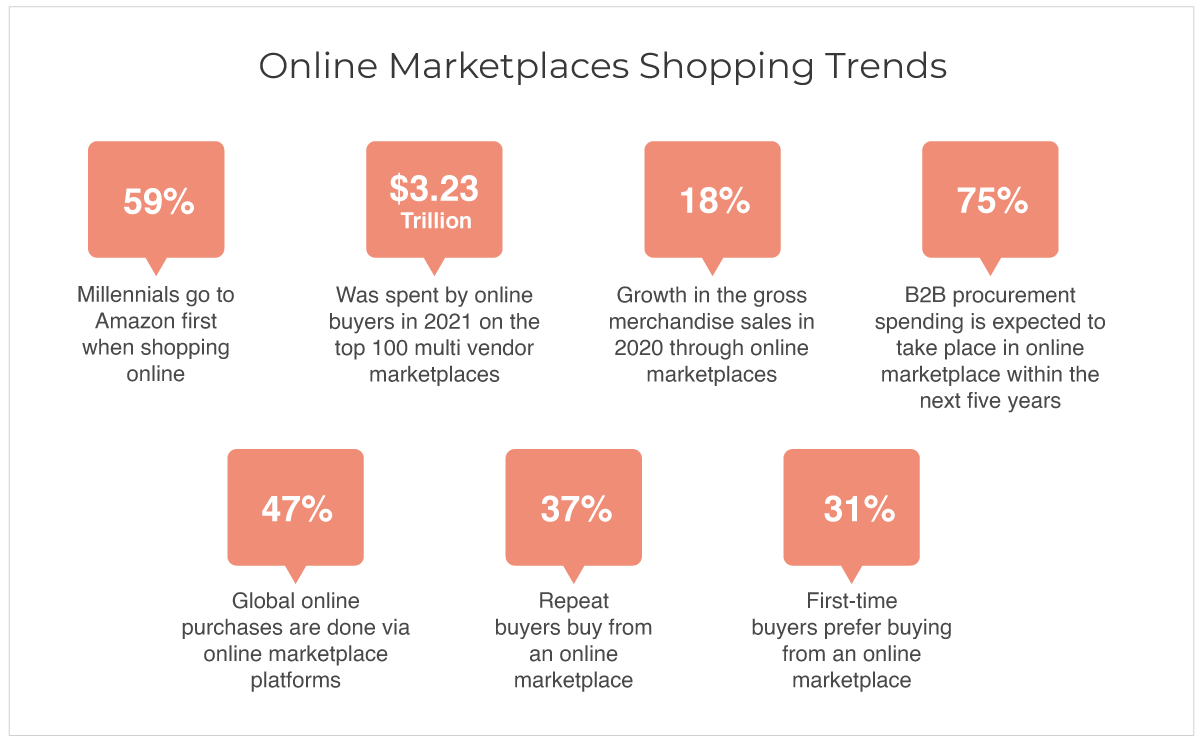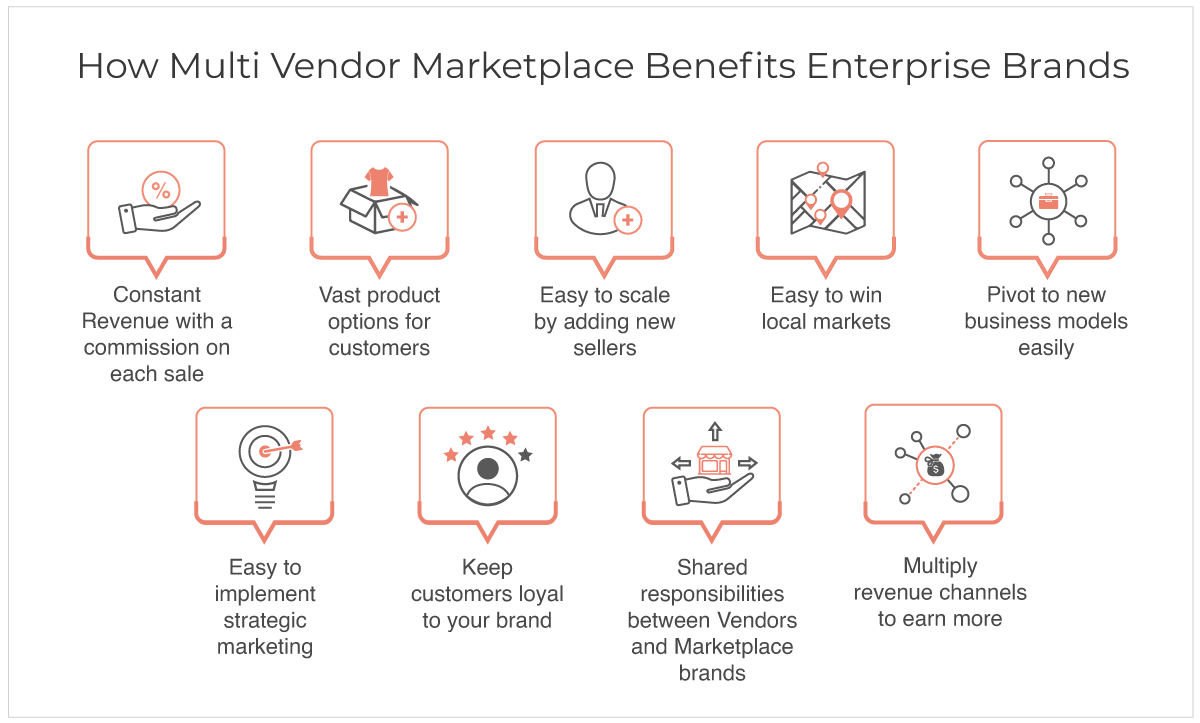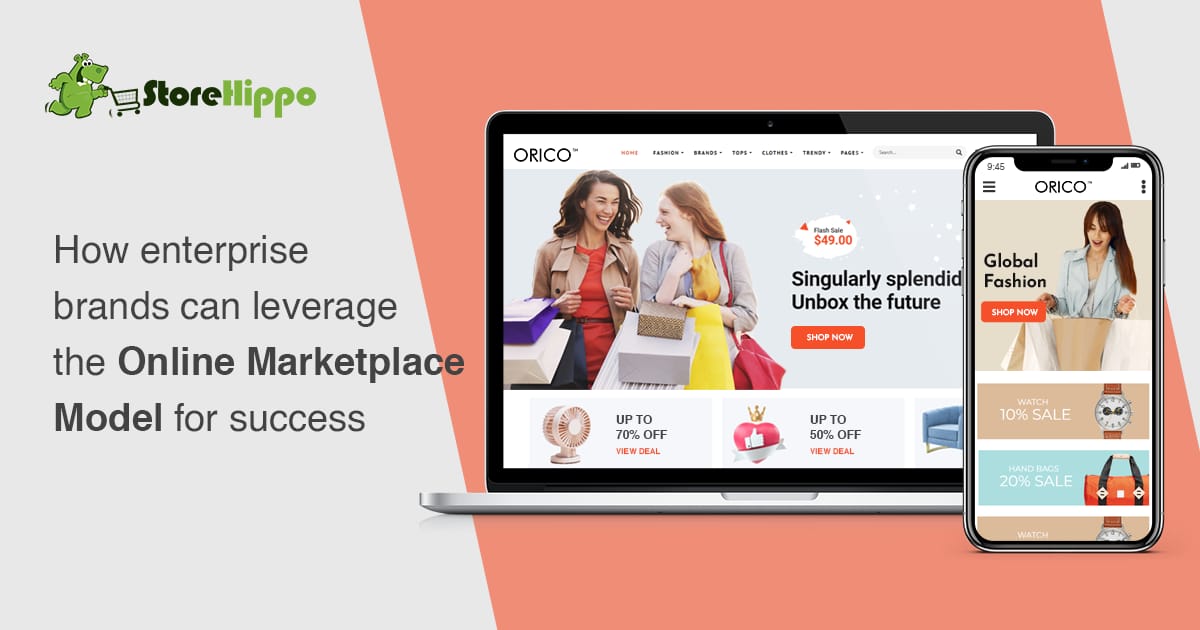Ok, let us answer a question.
What is the first thing you do when you want to purchase an item, say running shoes?
We bet you start by fishing your options on a multi vendor marketplace!
Right?
This is the standard practice for more than 48% of online buyers. And if your enterprise brand has not yet explored the goldmine called online marketplace, you are missing big-time on the opportunities to grow your brand.
Wonder why this business model is gaining such huge popularity? Let us help you understand.
Table of Contents
- The growing popularity of Online Marketplace around the globe
- Online Marketplace VS Online Store
- Reasons why the Multi Vendor Marketplace is the top choice of many enterprise brands
- 1. Constant revenue with a commission on each sale
- 2. Vast product options for customers
- 3. Easy to scale by adding new sellers
- 4. Easy to win local markets
- 5. Pivot to new business models easily
- 6. Easy to implement strategic marketing
- 7. Keep customers loyal to your brand
- 8. Shared responsibilities between Vendors and Marketplace brands
- 9. Multiply revenue channels to earn more
- Must-have features to build a successful Multi Vendor Marketplace
- Why enterprise brands trust StoreHippo to build their Online Marketplace
- Final words
The growing popularity of Online Marketplace around the globe
Marketplaces are undoubtedly the most preferred buying destination for modern buyers. With the convenience, variety of options, brand trust and competitive pricing, multi-seller portals have become more of a habit for online buyers.
Did you know that;

59% of the millennials go to Amazon first when shopping online
$3.23 trillion was spent by online buyers in 2021 on the top 100 multi vendor marketplaces
18% growth in the gross merchandise sales in 2020 through online marketplaces
75% of the B2B procurement spending is expected to take place in online marketplace within the next five years
47% of global online purchases are done via online marketplace platforms
37% of repeat buyers buy from an online marketplace
31% of the first-time buyers prefer buying from an online marketplace
The trends clearly show how buying patterns are significantly influenced by the shopping experiences on online marketplaces.
Online Marketplace VS Online Store
An online marketplace is also a type of ecommerce store, albeit with a more complex order flow. The main difference between these two models is the number of sellers they host. Let us understand both the models better:
Online Marketplace
An online marketplace has a number of sellers coming together to sell different or similar items on a single platform at competitive prices. This business model is commonly referred to as a multi vendor ecommerce website or as a zero inventory model.
Different sellers upload, display, and sell their products on the marketplace platform. These sellers then pay a commission to the marketplace owner for providing them with the service and a platform to sell their products. The entire platform’s IT and support part is managed by the marketplace brand.
A marketplace is a win-win model for both parties as the sellers are free from the technical aspects of the platform and the marketplace brand does not have to bother about inventory and logistics.
With good vendors on board, even more, vendors are attracted to the marketplace and with their products and competitive pricing, more customers flock to the marketplace website. Amazon, Flipkart, Myntra, eBay, and Walmart are some common and most loved multi vendor marketplaces.
Online Store
Anonline store has just one seller who is the owner as well as the sole vendor on the platform. An online store owner might be sourcing products from a number of brands, sellers or distributors or even manufacturing them in their own manufacturing units.To the end customers of the online store, all the goods or services sold on an online store appear to be sold by the brand, not different sellers.
The single-seller store is managed and run by a single entity. From deciding on the IT infrastructure to sourcing products and managing logistics, support, and everything is taken care of by the internal teams of the enterprise online store.
While enterprise brands can also go for this model, it is easier to manage their large business by onboarding their sellers and distributors as vendors on the brand portal.
Reasons why the Multi Vendor Marketplace is the top choice of many enterprise brands
The success of brands like Amazon, Zomato, Flipkart, Urban Clap etc. has proven beyond doubt that the marketplace model is loved by customers and vendors alike. The best thing about the model is that it can easily adapt to different industries and combine with other business models to create the most unique solution needed by brands to rule the market.

Let us look at what makes these multi seller stores the most preferred business model for enterprise brands:
1. Constant revenue with a commission on each sale
Every brand builds a business with the aim to earn better. With a multi vendor marketplace, you not only earn by selling your own branded products but also earn a commission with each sale that is made on the platform.
The model's inherent commission-based structure ensures a steady revenue source for the enterprise brand. With multiple vendors selling multiple products to the consumers, and with the commission plan, the marketplace brand continues to earn a fixed or variable commission with each sale. Along with the commission, the admin may also charge a small fee for listing the product on the platform.
2. Vast product options for customers
Now every business is out there in the market to acquire more customers. Attracting buyers to your brand requires some strategic thinking. With a multi vendor business model, you automatically have a rich catalogue to offer to your buyers.
With multiple products on the site, customers can easily compare products on the basis of sellers, prices, and other parameters - giving buyers the opportunity to make informed purchases. The availability of a large number of products also helps in boosting the footfall on the marketplace.
When buying online, 48% of the customers prefer going to a multi vendor marketplace first. After all, multi seller stores not only have the products one is searching for but also usually have many related products. We know from experience how tempting this is; as a result, customers frequently make impulse purchases and marketplace brands get bigger ticket sizes.
3. Easy to scale by adding new sellers
The aim of every business is to scale, grow and build a niche for the brand. By adopting the multi vendor model, the whole exercise of scaling the business becomes much easier and simpler as compared to a traditional business or a regular online store where the brand is responsible for inventory, promotions, operations et all.
For enterprises, scaling their business can be effortless if they just added the best sellers from different product lines or brands. As your brand continues to add new sellers, the business is scaled effortlessly.
For example, consider that you are starting an online marketplace for skincare products, but micro-managing a wide array of products combined with managing the entire website can be tedious. So you scale up your marketplace brand by onboarding sellers/brands or vendors who want to sell their products on your marketplace. And now you are now building a much richer catalogue for your consumers on your marketplace app.
4. Easy to win local markets
What happens as your business scale and your customer base shoots up? You would want to provide them with faster service, right? If you are wondering how to achieve the goal, here is the solution for you.
With the online marketplace model, it becomes easier to become the bestseller brand in the local markets. All you need to do is- add local vendors for faster delivery and consolidate your brand’s presence in new markets.Onboarding local vendors also gives your brand nuanced insights about the market and buyer behaviour which in turn help with strategic marketing and growth.
5. Pivot to new business models easily
The commerce world has changed like never before. To match pace with the changing market and buyer demands enterprise brands are changing and adapting their business model to suit the tastes of modern buyers.
For example, if your brand wants to attract local customers the best way to do this is to implement personalization and localization. Wouldn’t your multi vendor marketplace get more footfalls if you created a network of local storefronts, with the option to choose the preferred language of the buyer? What if you also offered personalized deals. Sounds like a recipe for success? It sure is.
As we saw, the online marketplace model in this use case is combined easily with two other popular business models, namely multi store network managed by a common central admin and multilingual solutions. This versatility of the marketplace model packs a powerful punch and gives enterprise brands a lead over competitors.
6. Easy to implement strategic marketing
Every business starts empty, but the power to pull customers is what makes it a home brand. The first step to achieving this equation with your marketplace brand’s buyers isto understand their preferences in terms of products, services and convenience they expect from your online marketplace brand.
Planning the growth and expansion of your business becomes easy when you have strategic inputs about your customers and a segmented approach to target them. For example, while you are targetting your home appliance buyers on your online marketplace, you can also flash home decor items during the festive season to grow sales. A different strategy like BOGO can be implemented for clothes and apparel and limited-time deals can be implemented for furniture items. This strategic planning gives the marketplace brand the flexibility to experiment with different marketing techniques and use a mix and match solutions to boost sales manifold.
7. Keep customers loyal to your brand
Customer loyalty is credible up to 12X of the first purchase, and it is the foremost thing to be considered while building an enterprise brand.
Now the question here is - How to drive the best-in-class customer loyalty? Well, the answer is to offer them what they get from no other brand. And yes, the game here is not only about product and prices, the new battleground is buyer experience.
With a well-designed multi-vendor marketplace, that connects with its buyers on multiple touchpoints like marketplace portal, marketplace app, mobile PWA stores etc. engaging, converting and retaining your buyers becomes much easier.
Also, with a vast product catalogue, controlling brand hopping becomes easier. When your customers get a variety of products on a single platform, they make your marketplace brand their ultimate search destination. Top this with some loyalty bonuses, faster shipping to members/frequent buyers etc. and you have your customers happy, glued, and loyal to your brand.
8. Shared responsibilities between Vendors and Marketplace brands
Whilst building an online enterprise brand, managing logistics that include storing, moving, and delivering goods to consumers is a formidable task. And it becomes even more challenging if you have a broad spectrum of products in your store.
But, with the multi vendor marketplace model, the responsibility of the logistics is shared by the vendors or distributors everything. When you have multiple vendors to look after their individual inventories, the stress is not passed on to the marketplace brand. The sellers maintain the entire logistics process of sourcing, stocking, and delivering, leaving the marketplace brand at peace to plan business growth.
The marketplace brand can help the sellers by offering them some sort of delivery service like Amazon does. This also can work as an added revenue stream for the marketplace brand while still limiting the logistics and inventory responsibility and leaving room to focus on business expansion strategies.
9. Multiply revenue channels to earn more
The potential a multi vendor marketplace holds is sometimes underestimated! Did you know that with minimal to no investment, it helps you create multiple revenue channels apart from the commissions you earn with every sale? Let us see how -
Sell your own products on the marketplace
Seller registration fees - a small token amount to let the sellers sell on your marketplace
Paid advertisement for some brands or categories
Extra charge for displaying featured products
Paid membership and loyalty programs for value-added services
A multi vendor marketplace opens up multiple channels of revenue growth and business scaling. But that’s not all! You need to have the right channel and tools to run a marketplace. This lucrative business model also helps lower the abandoned cart rate by giving your customers an option to choose from the numerous deals available on almost all products. When you have multiple small sellers in your shop, you tend to attract more customers. And this gives you a higher chance of success as compared to other business models.
Must-have features to build a successful Multi Vendor Marketplace
The extensive benefits of a multi vendor marketplace make it the top choice of many businesses that are planning to go online. Let us look at some features that come in handy when building a marketplace -
Built-in multi vendor module to launch the marketplace in no time using the plug-and-play solutions
Advanced and cutting-edge technology to keep the online marketplace brand ahead of the competition
High-performance, lightweight multi vendor ecommerce store that works seamlessly even when scaled to millions of users, products etc.
Simplified and user-friendly solutions for all the parties involved, ie, sellers, buyers and the admin(s)
Marketplace apps and PWA stores to leverage M-commerce and connect with the buyers on multiple customer touchpoints
Multiple payment options like payment gateways, store wallets, digital wallets, UPI etc. to ensure seamless checkouts
Easy to customize and personalize to keep buyers engaged
A complete solution to onboard, manage and pay out the vendors
Built-in marketing tools to implement different marketing strategies
Features to take the business to global markets and build hybrid solutions
With all these features in place the marketplace brand can implement various strategies to unleash growth.
Why enterprise brands trust StoreHippo to build their Online Marketplace
StoreHippo comes with a well rounder multi vendor marketplace solution for enterprise brands of every scale and size. The plug and play marketplace solutions are battle tested and can be easily customized to build tailor made solutions for brands.
Built on the cutting-edge MACH architecture and SPA, StoreHippo builds lightweight, user-friendly online marketplaces that can scale to any number of users, products, vendors or geolocations without compromising on performance.
StoreHippo also comes with customizable themes with support for multiple languages. The inbuilt support for different business models like multi store network, B2B, D2C, B2B2C, quick commerce, hyperlocal ecommerce etc. enables brands to build their own disruptive multi vendor marketplace model.
Built on the mobile-first principle StoreHippo comes with a built-in mobile apps builder to build the marketplace app. All stores powered by StoreHippo are PWAs and work like native apps when opened in a browser.
With pure headless architecture at its core, Storehippo makes it possible for enterprise brands to build highly personalized omnichannel buyer journeys. A gamut of built-in marketing tools of the SEO-friendly StoreHippo platform help in optimizing the platform better for more organic footfalls.
StoreHippo also comes with glocal ecommerce solutions, i.e; while brands can build multilingual marketplaces for international buyers they can also localize it using local payment and shipping solutions and by onboarding local vendors to give localized experience to its buyers.
Storehippo also offers 300+ built-in features, 120+ integrations to build out-of-box marketplaces. With 60+ payment gateways and 30+ logistics partners, StoreHippo makes it easy to streamline the online marketplace’s checkouts and deliveries.
Final words
A multi vendor marketplace can be a pot of gold for enterprise brands that learn to leverage the power of this much-loved business model. While business strategy is important in making a brand successful, choosing the right ecommerce platform to power your online marketplace can make all the difference.
The marketplace model can set an enterprise brand for growth when powered by a feature-rich platform and good vendors. An advanced marketplace builder like StoreHippo which comes with plug-and-play solutions for building a variety of horizontal, vertical, B2B, service aggregator and any other hybrid or custom marketplace can give enterprise brands an edge over their competitors. With a detailed and well planned vendor module the brand owners can easily amange any number of vendors, their products, discounts, shipping, payouts and commissions making it easy to manage the complete set up.
StoreHippo supports your enterprise business at each step while you focus on taking your brand forward. Explore StoreHippo’s growth-oriented features by starting your 14-day free trial today.


